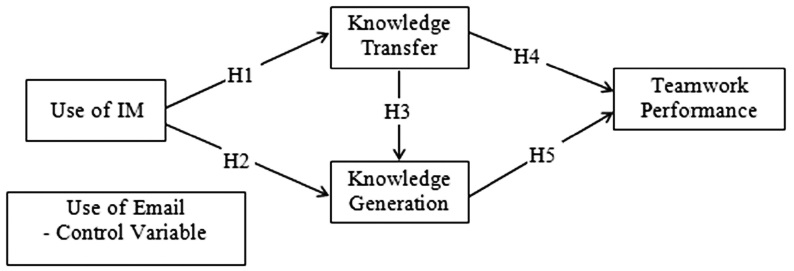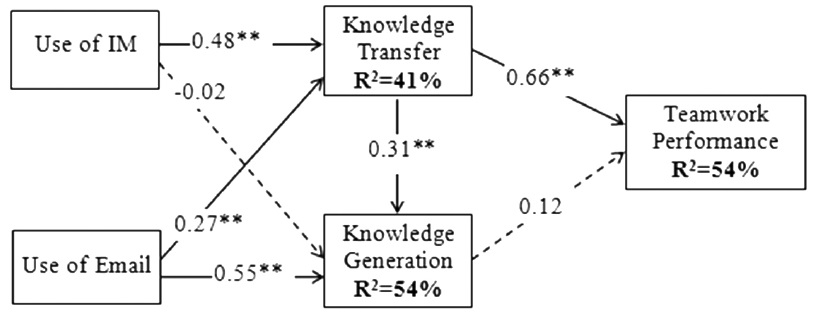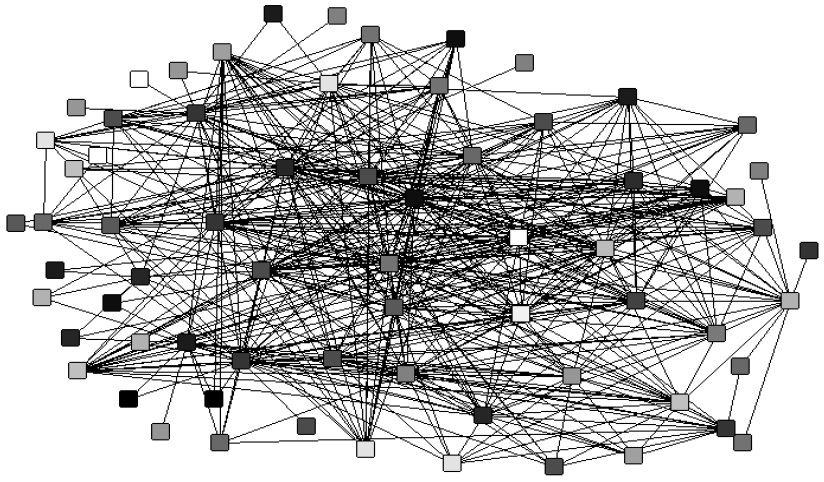



Advances in information technology (IT) have resulted in the development of various computer‐mediated communication (CMC) tools of which the instant messenger (IM) is one of the more prevalent. An IM tool has the capability to overcome geographical distance and facilitate “instant” interaction among interlocutors. Examples of IM tools include MSN Mesenger, QQ and Skype. While all of these IM tools incorporate avatars, video calls and other paralinguistic features, the text‐messaging and file transfer capabilities are most utilized by users. Researchers have demonstrated the potential of IMs for promoting multi‐tasking, as well as improving working efficiency (Cho, 2005; Quan‐Haase, 2005). For example, managers and employees often communicate with each other in multiple social networks ‐ they are not embedded in a single workgroup (Teigland, 2000). Given the flexibility provided by an IM, organizations increasingly allow employees to use IM as a substitute for email as they engage on collaborative tasks (Davison et al., 2013).
On the other hand, researchers have also pointed out that the interruptive nature of IM can negatively affect work efficiency and reduce productivity (Davison et al., 2013; Ou and Davison, 2011). Consistent with academic research, Deloitte (2009) revealed that only 41% of 750 surveyed companies allow the use of social networking tools such as IM in the workplace. Ou and Davison (2011) review the literature on interruptions and identify both positive and negative consequences. For instance, the pop‐up flashing icons that appear when an incoming message is received “demand the recipient’s immediate attention” (ibid.). Further, the polychronic communication that IM enables (i.e. communication among multiple connected individuals) may act to reduce an individual employee’s concentration (Garnett and Danziger, 2007). Although the interruptions associated with IM are widely recognised, these same interruptions are associated with “quick questions and clarifications, coordination and scheduling, [and] discussions of complex work” (Avrahami and Hudson, 2006). Although the positive consequences of IM use are undeniable, the under‐employment of IM tools at work may be due to the controversial impacts, as well as the lack of clear research evidence, related to the technology.
Given the above dilemma, in this study we investigate the impact of IM on knowledge management (KM) in the workplace. KM is a key business process responsible for shaping organizational competitive advantage (Nonaka, 1994). Prior research on KM has often focused on formal, enterprise‐wide KM systems (KMS) (Bock et al., 2005). The impact of informal CMC tools, such as IM, on KM has been overlooked. We argue that by connecting working professionals in multiple social networks, so IM has the potential to contribute to knowledge transfer and generation in the workplace, subsequently enhancing team performance.
In addition to investigating the contribution of CMC tools to KM, we also use the social network analysis (SNA) technique to develop the social network diagrams in order to visualize employees’ or team members’ email‐ and IM‐based interactions. Furthermore, SNA results enable an examination of the correlation between the elements of social networks (including degree centrality, closeness centrality, betweenness centrality, density and tie strength) and KM at work. These analyses have the potential to render us both theoretical and practical explanations with respect to KM where the network literature has previously provided few insights into the specific elements that facilitate knowledge transfer and generation.
In the following section, we propose a theoretical model, grounded on social network theories, to describe the impacts of IM and social networks on KM in the workplace. After describing how we conducted a survey in a small sized company in Hong Kong, we then present a combined analysis of the research model and the social networks that we discovered. We conclude the paper with key findings, implications, contributions and directions for future research.
We rely on social network theories (Wellman et al., 1996; Krackhardt, 1992; Granovetter, 1973) to develop the theoretical model about IM’s impacts on KM and subsequent work performance. Specifically, Wellman et al. (1996) coined the term “computer supported social networks” because computer networks connect people. In networks such as those facilitated by the Internet, individuals can seek information and collaborate online when they leverage these new modes of synchronous and asynchronous communication. Granovetter’s theory on the strength of weak ties (1973) suggests that individual members of social networks obtain novel information from other members with whom they have weaker ties. However, while weak ties may be more useful for obtaining or soliciting new knowledge, strong ties play a role in facilitating the knowledge transfer process (Krackhardt, 1992).
In this article, we draw on these social network theories to study the impacts of IM, as a social CMC tool, on facilitating KM and explore the downstream effects on work performance. Figure 1 outlines the research model. The definitions of constructs used are summarized in Table 1. We provide detailed arguments on the proposed research model in the following sections.
[Table 1.] Definitions of constructs and source
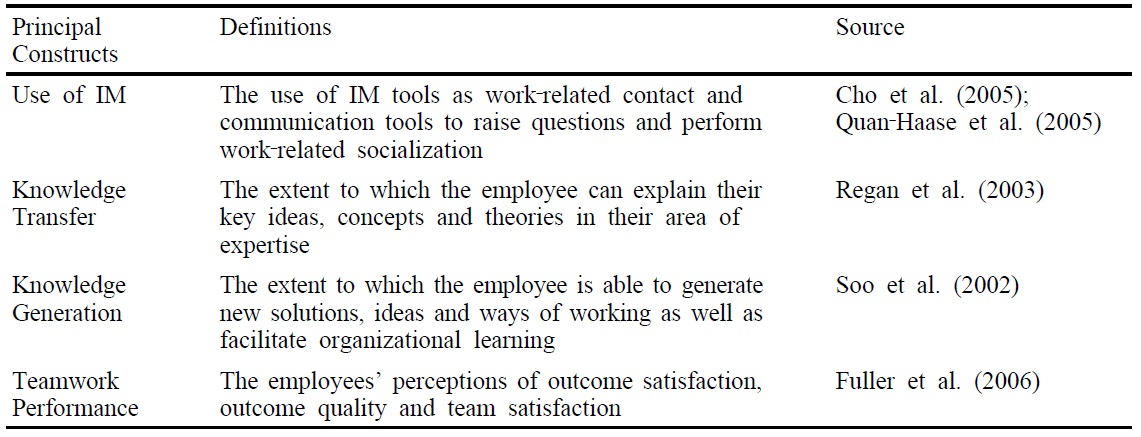
Definitions of constructs and source
2.1. The Impact of IM on Knowledge Transfer
KM has been defined as the process of capturing, storing, sharing and using knowledge (Davenport et al., 1998). In these four processes, knowledge transfer occurs whenever knowledge is diffused from one individual to others (Roberts, 2000). This diffusion can be effected through processes of socialization, education and learning (ibid.). More specifically, both conceptual (e.g., Krackhardt, 1992; Granovetter, 1973) and empirical (e.g., Levin and Cross, 2004) studies have suggested that weak ties within social networks foster information search activities, while strong ties facilitate knowledge transfer among individuals.
We argue that IM connects work professionals in a network (cf., Wellman et al., 1996). IM can stimulate instant interaction via the pop‐up message dialogue feature. The bi‐lateral, near synchronous form of communication then enabled closely resembles the openness and transparency associated with face‐to‐face communication (Ou et al., 2014). Unlike traditional social networks, IM‐enabled social networks are able to overcome the constraints imposed by temporal and spatial communication barriers which people often encounter in face‐to‐face social networks. With such rapid IM interaction, the development of strong ties between distributed team members no longer needs to rely on physical contact.
By connecting people, IM tools provide working professionals with a valuable channel for sharing, transferring and documenting knowledge. During the interaction process, team members can clearly negotiate work expectations, explore social contexts and collaborate on team work (Cho et al., 2005). Indeed, the characteristics of tools used to transfer knowledge have been found to affect the success of knowledge transfer (Argote, 2000). An IM’s informal and casual characteristics make it easier for team members to transfer knowledge. An IM therefore constitutes an effective CMC tool that can be used both for complex work collaboration and for simple task coordination. We thus propose that:
2.2. The Impact of IM on Knowledge Generation
Knowledge generation activities at work can occur in many different ways (Simon, 1991). In addition to information processing, organizations often generate new knowledge through action and interaction (Levinthal and Myatt, 1994). Scholars have suggested that knowledge generation requires intensive communication (Nonaka, 1994). Indeed, smooth knowledge generation often requires a robust yet informal communication network (Soo et al., 2002), because interlocutors need tools such as images and other visual aids to help them to present their ideas to others.
We argue that an IM is a very suitable tool to support the transmission of rich content. With such additional functions as file transfer and video conferencing, an IM can serve as a functionally rich CMC tool that facilitates the knowledge generation process. Knowledge workers can leverage an IM as a flexible and informal means to engage in intensive communication with their colleagues. Such information exchange allows new and innovative ideas to enter and flow through the company.
As suggested by the theory of weak ties (Granovetter, 1973), individuals often obtain more new information or ideas from weak ties than from strong ties within a social network. This is because weak ties play the role of an information “bridge” to connect different clusters of people who can then bring in new information. We argue that IM, in addition to facilitating intensive communication between strongly tied members of social networks, offers a valuable means to connect people together loosely. The list of contacts maintained in an IM tool are not restricted only to close friends or colleagues, but also include less frequently contacted individuals. In this sense, the contact records in an IM tool can be leveraged for searching information and identifying new knowledge. An IM provides a “bridge” for different clusters of people to get in touch when necessary and possibly to acquire new knowledge within a loosely connected social network. Putting the above arguments together, we therefore propose that:
2.3. Generating Knowledge via Knowledge Transfer
Knowledge generation is often related closely to the expansion of the existing knowledge pool (Tracey et al., 2002). Knowledge itself is thus an important source for further knowledge creation. According to Nonaka (1994), the process of knowledge creation involves interactions between explicit and tacit knowledge. In the process of knowledge generation, individuals may find it relatively easier to access and integrate knowledge with colleagues located in other offices (Teigland and Wasko, 2009), consistent with the theory of weak ties (Granovetter, 1973).
We argue that facilitating knowledge generation by knowledge transfer can be enhanced by the IM‐enabled work environment. The attributes of IM facilitate the conduct of searches for solutions or information across departments or even across national boundaries. By shaping the network structure, IM creates communication patterns that can affect knowledge structures, in terms of knowledge transfer and generation in organizations, and thus helps to spread knowledge widely within an organization. With the aid of IM tools in sharing visual, task‐related information, mutual understanding and new knowledge are more likely to be generated. We therefore propose that:
2.4. Enhancing Work Performance with Knowledge Transfer and Knowledge Generation
In a highly competitive and turbulent environment, organizations need to modify their structures continually. Strategic knowledge generation is viewed as fundamental to an organization’s development and to successfully building competitive advantage, especially in SMEs (Cantú et al., 2009). Increased frequency of interaction and knowledge sharing can enable more comprehensive consideration and comparison of alternative problem solutions. Such a knowledge sharing and transfer process can lead to improved decision making which will ultimately improve work performance (Stasser et al., 1985). Consistently, research (e.g., Srivastava et al., 2006) has provided empirical evidence for the positive relationship between knowledge sharing and teamwork performance.
The problems faced by companies have become more sophisticated in the current knowledge era. This situation often pushes companies to acquire or generate ever more innovative ideas in order to survive. This is especially true for SMEs, where there is little organisational slack. With new and innovative ideas flowing into workteams, SMEs may solve sophisticated problems more effectively, even with resource constraints. The greater the amount of knowledge that flows in to the organization so the greater the capability to solve problems in a more effective way (Soo et al., 2002). Meanwhile, the knowledge creation process will result in a stock of new knowledge and subsequently have a positive impact on the employees’ performance in the workplace. As a result, team performance will be influenced by those individuals who are able and willing to apply new knowledge in making decisions. Taking the above arguments together, we hence propose that:
2.5. Analytical Elements of Social Networks, IM and KM
From the SNA perspective, a social network refers to the social structure connecting individuals called nodes (Wasserman and Faust, 1994). The structure itself is tied by one or more relationships which, in the workplace, may include friendship, common interest, knowledge exchange, collaboration and collegiality (c.f., Cho et al., 2005).
In this study, we focus on the interrelationships among IM, KM and the analytical elements of a social network, including centrality, density and tie strength. The literature on KM has provided rich insights into the contribution of interpersonal relationships on knowledge sharing (e.g., Bock et al., 2005; Chow and Chan, 2008). However, the influence of the characteristics of interpersonal relationships and social networks (such as centrality, density and tie strength) on effective KM is yet to be identified.
Wasserman and Faust (1994) provide clear definitions of the analytical elements (i.e., measures) of social networks for the purpose of SNA. Specifically, centrality refers to how well the nodes connect to the network, which can be measured by betweenness (the extent to which a node lies between other nodes in the network), closeness (the degree to which an individual is near other individuals in a network), and degree (the count of the number of ties to other actors in the network). Density represents the proportion of ties in a network relative to the total number possible. Tie strength refers to emotional closeness between individuals (Granovetter, 1973), which can be vicariously measured by frequency of interaction, closeness and time known with other actors in a social network (Marsden et al., 1984; Marsden, 1990).
We argue that the use of IM can strengthen these characteristics of social networks, given that it is widely used to connect people and maintain interpersonal relationships socially (Li et al., 2005) as well as in the workplace (Cho et al., 2005). IM provides an effective communication channel to facilitate the collaboration among team mates or other organizational members at work, thus enhancing the connectivity of the interlocutors in social works in the workplace (i.e., centrality). It is easy to search for and add friends in the buddy list, facilitating the creation of “unforgettable” online contact lists and a well‐connected online network, and thus contributing to enhancing the density of social networks in the workplace. As explained in the previous sections, the instant interaction via IM can enable the team members to clearly negotiate work expectations and explore social contexts (Cho et al., 2005), and thus help strengthen the strong work‐related and interpersonal relationships among team members. We therefore hypothesize:
The literature on KM has suggested that a strong interpersonal relationship encourages knowledge sharing and transfer (Szulanski, 1996; Bock et al., 2005). From an SNA perspective, a dense and centralized network means individuals are well connected and individuals in the network know each other. We argue that density is positively associated with knowledge transfer. This is because a well‐connected network embeds some levels of cooperative relationship where everybody has the responsibility to cooperate and share knowledge. If the network members do not cooperate, non‐cooperation behavior will spread quickly to other network members and restrict their future interaction (Reagans and McEvily, 2003). However, we argue that a network characterized by an extremely high density and centrality (meaning nearly everybody connects with each other) may not be effective for generating new knowledge, since information is already available to everyone in the same social circle and little new knowledge may emerge. Such an argument is consistent with Granovetter’s (1973) theory of the strength of weak ties. Specifically, Granovetter (1973) argues that weak ties facilitate the creation of new knowledge, while strong ties contribute to comprehensive knowledge transfer. This is because “weak ties provide people with access to information and resources beyond those available in their own social circle; but strong ties have greater motivation to be of assistance and are typically more easily available” (Granovetter, 1983, p. 209). We therefore hypothesize:
In addition to IM, email is commonly encountered in organizations as a means to facilitate social networking and knowledge management. We thus account for the effect of email in the research model by incorporating this construct in our data analysis.
We targeted a small‐sized company in Hong Kong as our research focus. We used a survey to collect empirical data that was used to test the research model. We also undertook a social network analysis (SNA) of the survey data.
The company, which we refer to by the pseudonym of VL, had 75 employees at the time of our study. VL is composed of six departments: sales, marketing, customer service, logistics, accounting and IT. VL conducts its business around the Asia Pacific area, including Hong Kong, Taiwan, China and Singapore. Its main business is to develop and distribute communication systems, Internet software, security, network and media products. VL is headquartered in Hong Kong where there are two offices. It is a norm at VL that every employee from the CEO downwards has an IM tool installed in their computer This IM tool was developed by VL and incorporates both simple text messaging with avatars and a notification system that enables employees to communicate with other colleagues as they wish. The IM is also integrated with the system used to provide customer support services and solve customer problems.
We relied on existing measures to develop the survey questions. The independent variable, IM use at work, was measured by adapting scales from Kankanhalli et al. (2005) and Cho (2005) with four items. Knowledge transfer is measured with the three items developed by Reagans and McEvily (2003). Knowledge generation is measured by adapting five questions from Soo et al. (2002). Teamwork performance is measured with scales developed and validated in Fuller et al. (2006) in three sub‐constructs, viz., group satisfaction, outcome satisfaction and outcome quality, with three items in each sub‐constructs. Teamwork performance is operationalized in this study as a subjective measure at the individual level, by following Fuller et al. (2006), rather than an objective measure at the group level. This is due to the complexity of groups in this company. Firstly, individual employees belong to different groups. Secondly, we were unable to obtain responses from all group members. Using a group‐level measure would unreasonably bias the results in favour of those group members who did respond to our survey.
In addition to the above 7‐point Likert‐scale questions, the survey also includes the relational data collected for the SNA diagram. Specifically, the survey participants were asked to provide information on their interlocutors with respect to: the frequency of contacting them using the IM tool and email; the length of time they had known each person; and perceived closeness. These data can be used to measure the “tie strength” of interlocutors in a social network (Granovetter, 1973). A summary of all the measures used in the survey is available from the authors.
3.3. Social Network Analysis (SNA) Technique
Common SNA includes the calculation of several characteristics of a social network, viz., centrality, density and tie strength where centrality is decomposed into degree centrality, closeness centrality and betweenness centrality (Freeman, 1978; Borgatti et al., 2002). The method used to calculate the relative degree centrality of an individual is to divide the number of direct connections (degree) by the network size – see formula (1).
The typical way to measure the “closeness” of a point is that calculated from the ‘sum distance’, the sum of the geodesic distances to all other points in the graph (Sabidussi, 1966). If the matrix of distances between points in an undirected graph is calculated, the sum distance of a point is its column or row sum in this matrix. In this research, we use the sum distance as the indicator of “closeness” which a point with a low sum distance is close to a large number of other points. We list the calculation of closeness centrality in formula (2).
The calculation of betweenness centrality is based upon “the frequency with which a point falls between pairs of other points on the shortest or geodesic paths connecting them” (Freeman, 1978). In this sense, the betweenness of a point suggests “the extent to which an agent can play the role of a ‘broker’ or ‘gatekeeper’ with a potential for controlling flow of information and resources over others” (Scott, 1988). The centrality of Point k1) in terms of betweenness can be calculated with formula (3).
Density is a measure of network cohesiveness and is the ratio of existing number ties to the maximum possible ties possible. The number of lines in a graph is a directly reflected to its inclusiveness and the number of degrees of its points (Scott, 1988). We adopt the following formula (4) to calculate the density of the social network at VL
In social network studies, ‘emotional closeness’ is a commonly used indicator of tie strength resulting from extending Granovetter’s (1973) theoretical notion on “tie strength” (e.g., Borgatti et al., 2002). Other indicators of tie strength include ‘frequency of contact’ and ‘time known’ (Marsden et al., 1984; Marsden, 1990). The calculation of “tie strength” of an actor is measured as the average of all tie strengths in terms of frequency of interaction, closeness and time known with all other actors within the network (as shown in Table 2).
[Table 2.] Item Use for measuring Tie Strength

Item Use for measuring Tie Strength
In this research, data were collected from employees of VL on a voluntary basis. The employees were provided with both hard and soft copies of the survey questionnaire. Over a period of three weeks we collected 43 responses, a response rate of 57%. Due to incomplete responses, 2 responses were removed from the data analysis. Therefore a total of 41 valid responses were available for analysis. Table 3 summarizes the demographic data of the respondents.
[Table 3.] Demographic data of respondents (n=41)
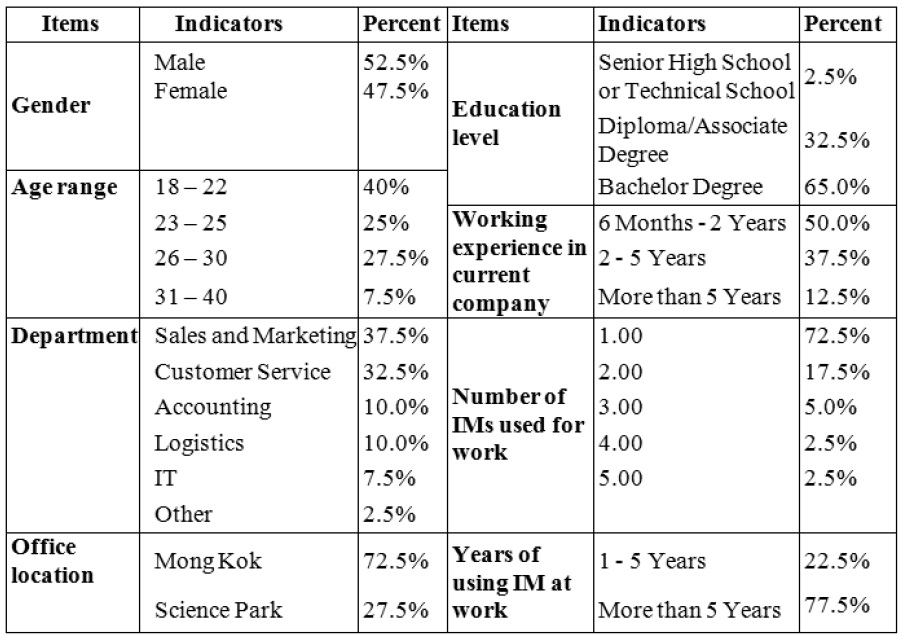
Demographic data of respondents (n=41)
1)According to such a measure, the larger the data related to “centrality closeness” between two individuals shown by the data actually suggests that they are more distant in the reality. This means that a reverse scale has been used to measure the actual centrality closeness.
We used the Statistical Package for the Social Sciences (SPSS) and Partial Least Squares (PLS) to calculate the validity and reliability of the constructs and the robustness of the research model.
4.1. Validating the Measurements
Firstly, the validity is confirmed by the factor analysis (omitted for brevity). All the eigenvalues of the constructs are larger than the suggested value of 1.0. The communality scores are higher than the suggested value (0.50). These results indicate adequate reliability of measures (Hair et al., 1995). Secondly, the reliability is validated by using Cronbach’s alpha and composite reliability scores. Cronbach’s alphas of all constructs range from 0.87 to 0.95 and all composite reliability are all above 90% which suggest acceptable internal consistency (Hair et al., 1995). The square roots of the Average Variance Extracted (AVE) are greater than 0.8 (see Table 4), which are greater than all other cross correlations; it implies that all of the constructs capture more construct‐related variance than error variance (Pavlou and Gefen, 2004).
[Table 4.] Descriptive statistics, correlation matrix, and AVE of principal constructs

Descriptive statistics, correlation matrix, and AVE of principal constructs
4.2. Testing the Research Model
The structural model in this study was examined with PLS. As shown in Figure 2, the results indicate that all hypotheses, except H2 and H5, are supported by the data. IM use at work has a significant positive effect (b=0.48, p<0.01) on knowledge transfer, supporting H1. Together with the usage of email at workplace, the Usage of IM at work explains 41% of the variance of knowledge transfer. The direct influence of the usage of IM on facilitating knowledge generation is moderate (b=‐0.02, p>0.01), rejecting H2. Regarding the impact of knowledge transfer on knowledge generation, the results provide support for H3 (b=0.31, p<0.01). Knowledge transfer also has a significant effect on the performance at workplace (b=0.66, p<0.01), validating H4. However, the path from knowledge generation towards work performance is not significant (b=0.12, p>0.01), rejecting H5. Knowledge transfer and generation explain 54% of the variance of work performance. In sum, the R 2 scores for all dependent variables and the high factor loadings yield an adequate goodness‐of‐fit for the overall research model (Chin, 1998).
4.3. Social Network Analysis (SNA)
With the collected data from the name generation process a social network diagram for VL is drawn using UCINET 7, relying on the calculations explained in the methodology (Figure 3). A total of 41 respondents participated in the name generation process with a total of 69 unique names produced as a result. To protect the participants’ privacy, we use a symbol, instead of the participant’s real name, in the diagram to present an individual employee. We discuss the corresponding insights drawn from the SNA diagram in the next section.
In addition to the SNA, we also use SPSS to perform a correlation analysis among IM usage and the attributes of the social network at VL. The results of the correlation analysis indicate the use of IM has a significant effect on some of the components of SNA (see Table 5).
[Table 5.] Correlation Table of Usage of IM and Social Network Components
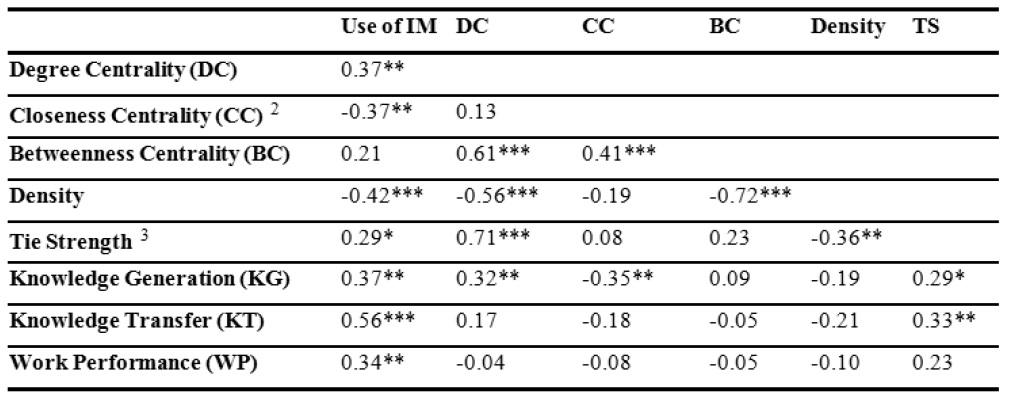
Correlation Table of Usage of IM and Social Network Components
The correlation analysis results shown in Table 5 indicate that the data supports H6a (b=0.37, p<0.01 for IM with degree centrality and close centrality) and H6c (b=.029, 0.05
5. Key Findings, Implications and Future Research
5.1. Findings Related to the Research Model
This research has a number of key findings. IM tools are well accepted as a social networking technology. This study provides empirical evidence that using IM tools at work can exert a positive effect on work performance via effective technology transfer. Although IM’s direct effect on knowledge generation is not significant, the analytical results indicate that IM use is highly correlated with knowledge generation (b=0.37, p<0.05). Our post hoc analysis indicates that knowledge transfer fully mediates the direct relationship between use of IM and knowledge generation. This full mediation effect suggests knowledge transfer is the building block of knowledge generation in the workplace. In other words, the easier it is for individuals to share knowledge with other colleagues, the more likely it is that new knowledge will be generated; however, the mere existence of IM is not sufficient for knowledge generation.
Surprisingly, our data did not support the hypothesis that knowledge generation at work will improve teamwork performance. This unexpected outcome can be explained as follows. In KM, one of the factors which affect knowledge sharing activities within an organization is the willingness of individuals to share the knowledge acquired or created by them (Bock et al., 2005). If the individual obtains new knowledge to solve a problem but decides not to share it, the overall performance of the team or the firm may not be enhanced (Gibbert et al., 2002). VL does not reward individuals who contribute new knowledge to the company due to the difficulties in quantifying new knowledge. Instead, the company looks at the final end results of sales figures and customer service evaluation. Thus, even if the employees have new knowledge or new ways of solving problems, the new knowledge may not necessarily be brought to the team or organizational level. Therefore knowledge generation at the individual level has much less influence on the overall improvement of the team or organizational work performance.
In addition, we conducted another post hoc analysis to investigate the correlation between the use of IM and email. The data suggests they are significantly correlated at r=0.44 (P<0.01). This suggests that the employment of IM doesn’t necessary reduce the use of email in the company, but each tool supplements the other instead of being mutually exclusive.
5.2. Findings Related to the Social Network Analysis (SNA)
Figure 3 visualizes the major social network at VL. According to this SNA, we include the means and standard deviations (STD) of the five critical characteristics of the social network, viz., tie strength, degree centrality, betweenness centrality, closeness and density. Our post hoc analysis of the social network suggests the social network enabled by IM is moderately dense (with a mean density of 0.48 out of 1). The average network size is 20. The betweenness of the social relationships varies considerably (with a mean of 61 and STD of 85). Five survey participants serve as “gate keepers” of the social network, with a betweenness value higher than 200. The average centrality degree is low at 0.30 (maximum of 1). This data suggests that there is still room for developing an efficient and well‐connected social network at VL.
Table 5 suggests the significance of IM in building the social network at VL. The use of IM is significantly correlated with all characteristics of the social network including degree centrality, closeness centrality, betweenness centrality, density and tie strength. Specifically, the correlation between IM use and degree centrality (b=0.37, p<0.05) implies that IM has enabled a quick and simple communication channel for users which will probably increase the ease of communicating and encouraging people to have more interactions with their colleagues even if they are located in different offices. Closeness centrality is measured by the distance among individual network members. The significantly negative correlation between IM and closeness centrality (b=0.‐27, p<0.05) implies that the distance of an individual from other people should be reduced when they use IM tools more frequently. Notably, the use of IM is negatively related to density of the network. Such a finding suggests the use of IM can create a sparse network. This is indeed consistent with the above social network diagram which suggests that VL only has a moderately dense network. IM tools can be used as a valuable means to maintain occasional contacts (i.e., people with weak ties) which are accessed only when necessary. IM tools thus help to spread the social network around. The data also implies the use of IM helps strengthen the ties between social actors (b=0.29, 0.05 Tie strength, proposed by Granovetter (1973), is expected to be positively correlated with knowledge transfer, but negatively correlated with knowledge generation activities. Our data provided strong support for the correlation between tie strength and knowledge transfer (b=0.33, p<0.05). However, our analysis also indicated that tie strength contributes to knowledge generation (b=0.29, 0.05
5.3. Theoretical and Practical Implications
Prior research (e.g., Cho et al., 2005; Quan‐Haase, 2005) has provided a foundation to investigate the significance of IM in enhancing social networks and work performance. The current study conceptualizes IM’s contribution to knowledge management, considering its valuable capability in enabling work professionals to instantly share and transfer specific knowledge to each other in real time. The utilization of the constructs of knowledge transfer and knowledge generation in the IM‐enabled communication provides social network studies a theoretical angle to investigate the effects of social networking tools in knowledge management as well as the subsequent impacts on teamwork or the organization as a whole.
At the same time, IS‐related social networking has received increased attention from both academics and practitioners. Most research has examined the social network as a whole and investigated its characteristics. Relying on the SNA technique, in this study we explored more specific components of a social network (including centrality, density and tie strength) and the relationship between the social networking tool (i.e. IM) with those components. Extending to the traditional knowledge management research, we quantify the organisational knowledge network map by articulating its key characteristics Among the first stream of research that integrates knowledge management together with the social network analysis, this research provides theoretical insights on what structural characteristics have the potential to influence the knowledge management efficiency and effectiveness in the relationship networks, in particular in the domains of knowledge transfer and knowledge generation. This research provides a springboard for further research on the effectiveness of other social network tools in shaping the social network and also provides a theoretical perspective to describe how to knowledge networks in organisations can be assessed, as well as to detect potential bottlenecks in knowledge transfer and generation.
Practically speaking, although a wide variety of information and communication technologies have been demonstrated to enhance the working efficiency and productivity of individuals, groups, organizations and society at large, the benefits are not automatic. The mere provision of technology will not result in significant benefits. Instead, technologies need to be applied sensitively and creatively to specific organisational problem situations or opportunities. IM is one such technology that can play a useful role in individual, team and organisational communications, helping improve performance. For instance, the flexibility and informality of IM tools enables employees to retain control of their communication in the workplace, task activities and team work. The flexibility that informal IT applications offer is important, because it enables employees to escape the rigid confines of formal corporate systems. While formal KM systems are doubtless effective, they also constrain knowledge sharing by forcing knowledge into pre‐formed structures. IM tools can equally be used to record and codify knowledge between individuals who interact online. We believe the use of IM can be also extended from individual networks to organizational contexts, as in the current case company, and even applied to other industries like health care. The informal communication and discussion among specialists can be facilitated by IM tools, so long as privacy concerns are carefully monitored. In another case, if the IM tool is hosted on a corporate platform, the discursive content should be archived and hence accessible by other work professionals looking for similar ideas or knowledge. In this way, IM can effectively function as a productivity tool that facilitates real‐time exchange of knowledge.
The current study provided empirical evidence for the positive contributions that the adoption of IM tools in the workplace can bring by facilitating the process of knowledge management. Future research across a variety of settings and in different national cultures and organisational contexts is needed if we are to usefully evaluate the negative values that are associated with the use of IM tools (e.g. interruption to operations, security issues, etc.). By including the negative impacts of IM used at work, we can achieve a more complete overview for the adoption of IM tools in the workplace.
In terms of analysis, this study measured perceived teamwork performance at the individual level. Future research can aggregate teamwork performance at the individual level to a group level for a more comprehensive analysis. Analytical rigor can be further enhanced by collecting both subjective and objective measures for all constructs used in the research.
Due to the constraints associated with the company studied, we only investigated one social networking tool, i.e., IM, in this research. However, IM is not the only social networking tool that can be used in organizations. Other Web 2.0 tools, such as Facebook and Twitter, can also be applied to knowledge management activities, as well as marketing and product design (Deloitte, 2009). Research into both theoretical and empirical aspects of the utilization of social networking tools in the organizational context will enrich our understanding of the relationships among social networks, IT and the SNA technique, as well as how social networking tools can render organizations competitive advantage.
A well‐connected social network in the workplace can augment the organization’s collective knowledge and sharpen its capability to act on what people know in time. By connecting people with various social networking tools, such as IM, blogs, Facebook and Twitter, the organization can become an effective web of interaction. This study provides a compelling rationale to embed social network tools into the organizational context. The technology related to social networking tools is evolving. We believe more theoretical and practical research will emerge in this field.
